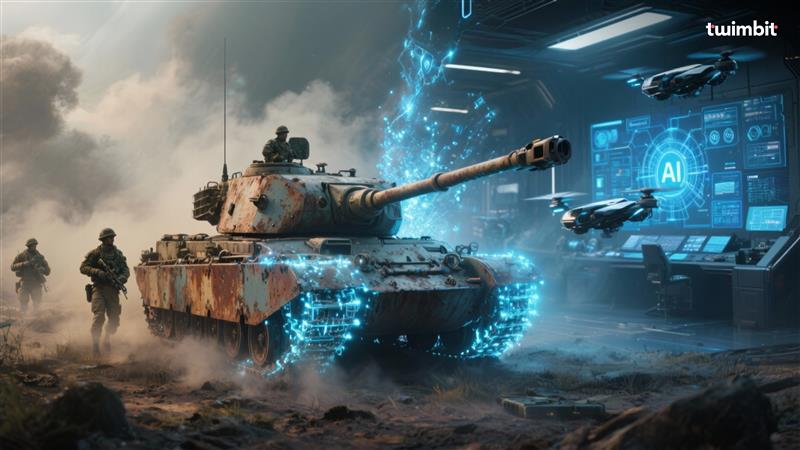November 11, 2025

Global defense spending has soared to over $2.7 trillion annually, yet much of it still flows into tanks, submarines, and manned jets built for 20th-century warfare. This continues even as conflict rapidly evolves into a digital domain dominated by AI, cyber, space, autonomous systems, drones, and electronic warfare.
Adversaries are investing in hacking networks, drone swarms, and orbital assets while many nations remain tied to costly, slow-moving arsenals. In Ukraine, for example, low-cost drones have decimated expensive tanks and artillery, exposing the limits of traditional hardware against agile, tech-driven tactics.
Modern conflict now rewards intelligence, automation, and connectivity over size and firepower. States that fail to adapt risk spending more yet achieving less real security.
If warfare is now about software and networks as much as soldiers and nukes, why do we continue to budget as if it’s 1970? One reason is bureaucratic siloing. Many have a Ministry of Defense (MoD) and a separate Ministry of Digital Transformation (or Technology) that remain disconnected from defense spending strategies, each pursuing separate agendas. Meanwhile, defense ministers keep signing off billions for submarine bricks, gigantic hardware projects, instead of investing in agile, AI-enabled defense technologies that reflect modern warfare realities.
This divide wastes resources and slows modernization. Governments that align defense and digital priorities see faster innovation, stronger cyber and AI capabilities, and better value for money, freeing funds for broader national growth in areas infrastructure, education, or healthcare.
Encouragingly, several countries have recognized the need to pivot and are taking concrete action:
Investing in legacy weapons over digital capabilities is a strategic error. Nations prioritizing defense tech today will secure both strength and prosperity, while those stuck in the old arms race risk irrelevance.
Many ASEAN countries have moderate defense budgets relative to their economies, typically around 1-2% of GDP.
ASEAN spends about $48 billion on defense, under 2 percent of global totals. With limited budgets, digital investments offer greater leverage. Singapore’s $14.6 billion could strengthen AI command and space surveillance, while Indonesia’s $11.2 billion could expand maritime drones and satellite monitoring. The Philippines and Thailand would gain more deterrence from radar, UAVs, and cyber defense than from armor. A digital first approach delivers more capability per dollar than traditional arsenals.
Change is hard because the defense industrial complex is entrenched. A handful of giant contractors dominate global budgets and have every incentive to preserve the status quo. Consider the top 10 defense firms (by 2024 defense revenue in USD):
These companies collectively pull in hundreds of billions of dollars each year by building fighter planes, tanks, missiles, warships, electronics, and increasingly, cyber and space systems. This “vast $2.6 trillion industry” and its concentration highlights how deeply traditional defense spending is ingrained.
Many contractors are investing in new tech themselves (for instance, Lockheed and RTX jointly developed the Javelin anti-tank missile and are working on hypersonics). New defense tech firms like Anduril exemplify the rise of agile defense tech. With $1 billion in 2024 revenue and a $30 billion valuation, it has secured major U.S., UK, and Australian contracts worth over $1.7 billion, showing how software-driven firms now rival legacy primes in building the digital core of defense. As governments reallocate budgets toward AI, cyber defense, and drones, industry output will shift from steel to software.
All this boils down to a fundamental question: Are we funding the forces of the future or those of the past? By 2050, warfare will look nothing like before. A landmark Air Force report predicted it will be defined by:
Future wars will reward those who are smart, connected, and agile, not just large and loud. A laptop-guided drone or cyber strike can now achieve what once required fleets and battalions. Military power will be defined by algorithms and bandwidth as much as firepower. Nations must ask: are our budgets preparing us for that reality?
Defense budgets still reflect Cold War priorities, favoring tanks and ships over digital capabilities. This approach wastes resources and leaves nations less prepared for modern conflict. Digital transformation is no longer optional; it defines military effectiveness.
Redirecting funds toward AI, cyber defense, space, and unmanned systems can deliver greater capability at lower cost. The real change lies in shifting from firepower to intelligence, from hardware accumulation to connected, data-driven readiness.
Defense and Digital ministries must plan jointly, aligning innovation and national security goals. Smart spending on dual-use technologies strengthens defense while fueling broader economic growth.
Modern defense strategy is about efficiency, resilience, and technological edge. Nations that modernize now will protect both their security and their prosperity.
Bottom line: From Silicon Valley to the battlefield, the writing is on the wall: adapt or fall behind. It’s time to turn our swords into smartphones or at least, to make sure our swords are smart. The nations that invest in the future will inherit it. Let’s make sure we’re among them.